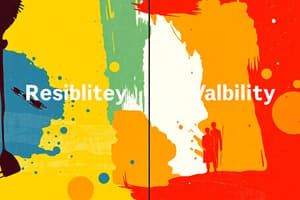Podcast
Questions and Answers
What does the standard error of estimate primarily indicate?
What does the standard error of estimate primarily indicate?
- The accuracy of a test's claims about its measurement.
- The variability of scores on a test.
- The dispersion of error in the distribution. (correct)
- The precision of a test in predicting a specific outcome.
Which statement best defines the standard error of measurement?
Which statement best defines the standard error of measurement?
- The expected correlation of the test when compared to other test with comparable constructs.
- The consistency of test scores across different administrations.
- The variability of true scores around the observed score. (correct)
- The distance between an individual's observed score and their true score.
Which process is key for establishing test-retest reliability?
Which process is key for establishing test-retest reliability?
- Comparing test results with a relevant criterion measure.
- Assessing the test's face validity.
- Evaluating convergent validity with related measures.
- Administering the same test to the same individuals on two occasions, and then calculating the correlation. (correct)
What is the most accurate description of what a test represents?
What is the most accurate description of what a test represents?
Based on the study guide, which of these options is NOT considered a type of test?
Based on the study guide, which of these options is NOT considered a type of test?
What are the names of the levels defining Test Purchaser competencies?
What are the names of the levels defining Test Purchaser competencies?
A test that assesses whether a measure assesses the theory that it claims to represent is called...
A test that assesses whether a measure assesses the theory that it claims to represent is called...
If a test's results correlate strongly with other similar tests, what kind of validity is this measuring?
If a test's results correlate strongly with other similar tests, what kind of validity is this measuring?
What does it mean for a test to have content validity?
What does it mean for a test to have content validity?
If a test does not correlate with measures of unrelated constructs, what type of validity does it demonstrate?
If a test does not correlate with measures of unrelated constructs, what type of validity does it demonstrate?
Which validity type assesses whether a test looks like it measures what it should?
Which validity type assesses whether a test looks like it measures what it should?
Which of the following is considered a source of measurement error?
Which of the following is considered a source of measurement error?
What is the purpose of the Kuder-Richardson-20 (KR-20) formula?
What is the purpose of the Kuder-Richardson-20 (KR-20) formula?
What is the main purpose of the Spearman-Brown formula?
What is the main purpose of the Spearman-Brown formula?
In psychometrics, what does Item Response Theory (IRT) focus on?
In psychometrics, what does Item Response Theory (IRT) focus on?
How does Item Response Theory (IRT) differ from classical test theory (CTT)?
How does Item Response Theory (IRT) differ from classical test theory (CTT)?
What is the psychometric term 'norm' referring to?
What is the psychometric term 'norm' referring to?
What defines a norm-referenced test?
What defines a norm-referenced test?
What does a criterion-based test measure?
What does a criterion-based test measure?
What is the core idea behind the domain sampling model?
What is the core idea behind the domain sampling model?
Which of the following is NOT a source of measurement error?
Which of the following is NOT a source of measurement error?
Which reliability type would be assessed with test-retest methods?
Which reliability type would be assessed with test-retest methods?
What does parallel forms reliability assess?
What does parallel forms reliability assess?
Which of the following best describes the relationship between standard error of estimate and standard error of measurement?
Which of the following best describes the relationship between standard error of estimate and standard error of measurement?
A researcher is testing the reliability of a new personality inventory. If they administer the inventory once and then, two weeks later, administer it again to the same group of individuals and finds a high positive correlation between the two sets of scores, which method of establishing reliability is being demonstrated?
A researcher is testing the reliability of a new personality inventory. If they administer the inventory once and then, two weeks later, administer it again to the same group of individuals and finds a high positive correlation between the two sets of scores, which method of establishing reliability is being demonstrated?
A test is developed to measure a person's level of introversion. It correlates positively with similar measures of introversion, but does not significantly correlate or has a small correlation with an unrelated measure of verbal reasoning. This pattern of correlations provides evidence for what types of validity?
A test is developed to measure a person's level of introversion. It correlates positively with similar measures of introversion, but does not significantly correlate or has a small correlation with an unrelated measure of verbal reasoning. This pattern of correlations provides evidence for what types of validity?
A test developer wants to know if all of the items in their new test assess the same construct. Which method would best measure this?
A test developer wants to know if all of the items in their new test assess the same construct. Which method would best measure this?
A graduate admissions test aims to predict student success in their program. This is an example of which type of validity?
A graduate admissions test aims to predict student success in their program. This is an example of which type of validity?
Flashcards
Standard Error of Estimate
Standard Error of Estimate
The standard error of estimate is a measure of how accurate test scores are at predicting a criterion.
Standard Error of Measurement
Standard Error of Measurement
The standard error of measurement is the standard deviation of observed scores around the true score.
Test-retest Reliability
Test-retest Reliability
Test-retest reliability is a method of establishing reliability by administering the same test twice to the same group of individuals and then calculating a correlation coefficient between the scores
What is a Test?
What is a Test?
Signup and view all the flashcards
Types of Tests
Types of Tests
Signup and view all the flashcards
Construct Validity
Construct Validity
Signup and view all the flashcards
Convergent Validity
Convergent Validity
Signup and view all the flashcards
Concurrent Validity
Concurrent Validity
Signup and view all the flashcards
Content Validity
Content Validity
Signup and view all the flashcards
Predictive Validity
Predictive Validity
Signup and view all the flashcards
Discriminant Validity
Discriminant Validity
Signup and view all the flashcards
Face Validity
Face Validity
Signup and view all the flashcards
Face Validity
Face Validity
Signup and view all the flashcards
Measurement Error
Measurement Error
Signup and view all the flashcards
Kuder-Richardson-20 (KR-20)
Kuder-Richardson-20 (KR-20)
Signup and view all the flashcards
Spearman-Brown Formula
Spearman-Brown Formula
Signup and view all the flashcards
Item Response Theory (IRT)
Item Response Theory (IRT)
Signup and view all the flashcards
Norms
Norms
Signup and view all the flashcards
Norm-Referenced Test
Norm-Referenced Test
Signup and view all the flashcards
Criterion-Referenced Test
Criterion-Referenced Test
Signup and view all the flashcards
Domain Sampling Model
Domain Sampling Model
Signup and view all the flashcards
Reliability Methods
Reliability Methods
Signup and view all the flashcards
Study Notes
Test Reliability and Validity
- Standard Error of Estimate: An estimate of the variability of a score on a test.
- Standard Error of Measurement: The standard deviation of observed scores around the true score.
- Test Reliability: The consistency of scores over multiple administrations or by different versions of the test. Established by administering the same test twice to the same group and correlating the scores.
- Test: A standardized procedure for observing behavior (key word: standardized).
- Types of Tests: Norm-referenced, criterion-based, standardized, non-standardized, multiple-choice, essay.
Test Validity
- Construct Validity: Assesses if a test measures the intended theoretical construct.
- Convergent Validity: Extent a test correlates with other measures of the same construct.
- Discriminant Validity: Extent a test does not correlate with measures of unrelated constructs.
- Criterion Validity: Extent a test predicts an outcome or correlates with a criterion measure (obtained at the same time is called concurrent validity).
- Face Validity: Subjective assessment of whether a test appears to measure what it's supposed to.
- Content Validity: Assesses if the test content represents the content domain it's intended to measure.
- Sources of Measurement Error: The testing situation, test taker variables, and item selection.
Reliability Methods
- Kuder-Richardson-20 (KR-20): Estimates a test's internal consistency reliability.
- Spearman-Brown formula: Estimates reliability implications of test length changes.
- Item Response Theory (IRT): Analyzes test items in relation to test-taker ability. IRT differs from classical test theory in that it focuses on the relationship between individual items and the latent trait, as opposed to the classical approach that focuses on the total test score.
- Test-Retest Reliability: Assess the consistency of scores over time.
- Parallel Forms Reliability: Consistency between different versions of the same test.
- Split-Half Reliability: Measures consistency by splitting a test into halves and correlating the results.
- Cronbach's Alpha: Measures internal consistency reliability.
- Item Analysis: Reviews each item's statistical properties and contribution to the test. Analyzes item difficulty and discrimination.
Test Scores and Norms
- Norm: Scores or data against which an individual's score is compared.
- Norm-Referenced Test: Compares an individual's score to a norm group.
- Criterion-Referenced Test: Compares an individual's score to an established standard of performance.
- Domain Sampling Model: Test items are sampled from a larger domain of possible items.
Additional Points
- Item Difficulty: Proportion of test takers answering an item correctly.
- Item Discrimination: How well an item differentiates between high and low scorers.
- Types of Scales: Different measurement scales used in tests.
- Types of Norms: Different methods for establishing norms (e.g., norm-referenced, criterion-based).
- Test Score Theory and Domain Sampling Model: These concepts are part of test score theory and explain how test items are selected and what that means for the results.
- Sources of Error: Sources of error in test scores are covered and include the testing situation, test taker variables, and item selection.
Studying That Suits You
Use AI to generate personalized quizzes and flashcards to suit your learning preferences.




